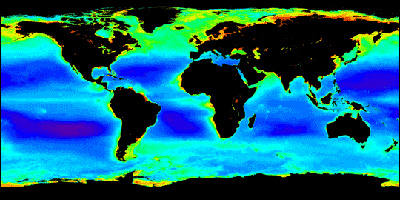New research discredits a $100 billion geoengineering fix to global warming
New research discredits a $100 billion geoengineering fix to global warming
Michael Lutz, University of Miami
November 29, 2007
Scientists have revealed an important discovery that raises doubts
concerning the viability of plans to fertilize the ocean to solve
global warming, a projected $100 billion venture.
Research performed at Stanford and Oregon State Universities,
published in this month’s Journal of Geophysical Research, suggests
that ocean fertilization may not be an effective method of reducing
carbon dioxide in the atmosphere, a major contributor to global
warming. Ocean fertilization, the process of adding iron or other
nutrients to the ocean to cause large algal blooms, has been proposed
as a possible solution to global warming because the growing algae
absorb carbon dioxide as they photosynthesize.
 This SeaWiFS image shows average chlorophyll a concentration from October 1997 to April 2002. Image courtesy of the SeaWiFS Image Gallery Geoengineering cure for global warming could cause problems Proposed geoengineering schemes to reduce global warming may do more harm than good, warns a new study published in Geophysical Research Letters. WWF condemns iron fertilization scheme to fight global warming |
However, this process, which is analogous to adding manure to a lawn
to help the grass grow, only reduces carbon dioxide in the atmosphere
if the carbon incorporated into the algae sinks to deeper waters as
they algae eventually die. This process, which scientists call the
“Biological Pump”, has been thought to be dependent on the abundance
of algae in the top layers of the ocean. The more algae in a bloom,
the more carbon is transported, or “pumped”, from the atmosphere to
the deep ocean.
To test this theory, researchers compared the abundance of algae in
the surface waters of the world’s oceans with the amount of carbon
actually sinking to deep water. They found clear seasonal patterns in
both algal abundance and carbon sinking rates. However, the
relationship between the two was surprising: less carbon was
transported to deep water during a summertime bloom than during the
rest of the year.
“This discovery is very surprising”, said lead author Dr. Michael
Lutz, now at the University of Miami’s Rosenstiel School of Marine and
Atmospheric Science. “If, during natural plankton blooms, less carbon
actually sinks to deep water than during the rest of the year, then it
suggests that the Biological Pump leaks. More material is recycled in
shallow water and less sinks to depth”, said Lutz. “Ocean
fertilization schemes, which resemble an artificial summer, may not
remove as much carbon dioxide from the atmosphere as has been
suggested because they ignore the natural processes revealed by this
research”.
 Iron boosts carbon sequestration by the ocean Wind-blown iron contributes significantly to the biological productivity of the Southern Ocean near Antarctica, researchers report in this week’s issue of the journal Science. |
This study closely follows a September Ocean Iron Fertilization
symposium at the Woods Hole Oceanographic Institution (WHOI) attended
by leading scientists and concerned representatives from governmental,
business, and environmental organizations. Topics discussed included
potential environmental dangers, economic implications, and the
uncertain effectiveness of ocean fertilization. To date none of the
major ocean fertilization experiments have verified that a significant
amount deep ocean carbon sequestration occurs. Scientists suggested
that verification may require more massive and more permanent
experiments.
During the Ocean Iron Fertilization meeting Dr. Hauke Kite-Powell, of
the Marine Policy Center at WHOI, estimated the future value of ocean
fertilization at $100 billion of the emerging international carbon
trading market, which has the goal of mitigating global warming.
Scientists cautiously plan to go ahead with large-scale and more
permanent ocean fertilization experiments and note that potential
negative environmental consequences must be balanced against the harm
expected due to ignoring climate change.
However, the global study of Dr. Lutz and colleagues suggests that
greatly enhanced carbon sequestration should not be expected no matter
the location or duration of proposed large-scale ocean fertilization
experiments.
Dr Lutz said “The limited duration of previous ocean fertilization
experiments may not be why carbon sequestration wasn’t found during
those artificial blooms. This apparent puzzle could actually reflect
how marine ecosystems naturally handle blooms and agrees with our
findings. A bloom is like ringing the marine ecosystem dinner bell.
The microbial and food web dinner guests appear and consume most of
the fresh algal food.”
“Our study highlights the need to understand natural ecosystem
processes, especially in a world where change is occurring so
rapidly,” concluded Dr. Lutz.
The findings of Dr. Lutz and colleagues coincide with and affirm this
month’s decision of the London Convention (the International Maritime
Organization body that oversees the dumping of wastes at sea) to
regulate controversial commercial ocean fertilization schemes. This
gathering of international maritime parties advised that such schemes
are currently not scientifically justified.
Strategies to sequester atmospheric carbon dioxide, such as ocean
fertilization, will be considered by international governmental
representatives during the thirteenth United Nations Framework
Convention on Climate Change conference in Bali next month.
More information
CITATION: Michael Lutz, Ken Caldeira, Robert Dunbar, and Michael Behrenfeld,
Seasonal rhythms of net primary production and particulate organic
carbon flux describe biological pump efficiency in the global ocean.
Journal of Geophysical Research, Vol. 112, C10011,
doi:10.1029/2006JC003706 (2007)